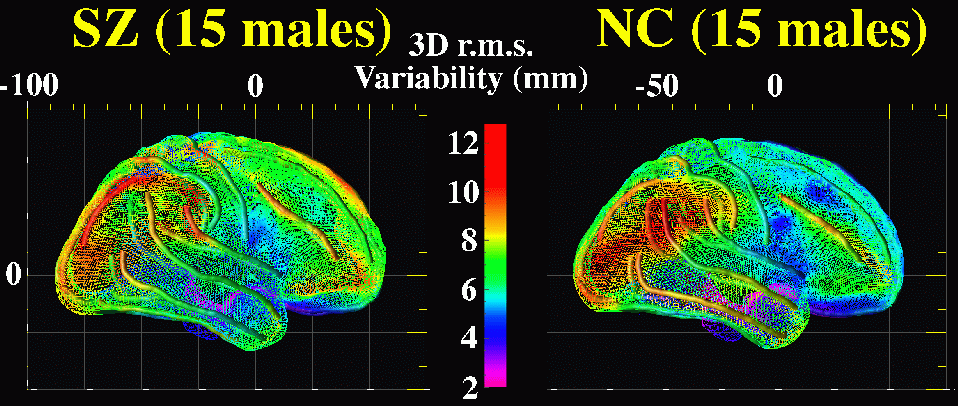
3D Cortical Pattern Variability in
Schizophrenic Patients and Matched Normal Subjects.
These maps are made using new mathematical and computational
strategies for cortical mapping and for creating
population-based brain atlases.
Narr KL, Thompson PM, Sharma T, Moussai J, Toga AW
Laboratory of Neuro Imaging, Dept. Neurology, Division of Brain Mapping,
UCLA School of Medicine, Los Angeles CA 90095, USA,
and
Institute of Psychiatry, London

3D Cortical Pattern Variability in
Schizophrenic Patients and Matched Normal Subjects.
These maps are made using new mathematical and computational
strategies for cortical mapping and for creating
population-based brain atlases.
Introduction. Neuroanatomic abnormalities are characteristic in schizophrenic populations. Cerebral anomalies include alterations in sulco-gyral patterns [1] and alterations in cerebral asymmetries [2],[3].
Methods. High-resolution (256x256x124; 1.5mm separation) T1-weighted MR images from schizophrenic patients (10f/15m, age: 31.0 yrs.+/-5.6 SD) and controls (13f/15m, age: 30.5+/-8.7) were aligned and scaled to Talairach AC-PC distance. To map group variability and asymmetry in sulci and surrounding anatomy, 3D cortical extractions from MR scans were obtained and brought into register using surface warping algorithms that enable averaging of equivalent cortical regions delineated by tracing major hemispheric sulci across subjects [4],[5]. 2 (Sex) by 2 (Diagnosis) by 2 (Hemisphere) ANOVAs quantified left/right cerebral asymmetries in stereotaxic co-ordinates of (1) the Sylvian fissure; (2) the superior and inferior temporal sulci; and (3) the postcentral sulcus, and included AC-PC distance as a covariate.
Results. Variability maps revealed different profiles of sulcal variability across groups and distinct asymmetries in temporo-parieto sulci within groups, that were confirmed in statistical analyses. In patients surface variability was increased in frontal regions compared to controls. Overall, maps of cortical surface variability indicated increased individual differences in neopallial association areas in respect to phylogenetically older areas of cortex.
Conclusion. Variability maps and statistical analyses revealed robust asymmetries in sulcal geometry that did not deviate in schizophrenic subjects. Different patterns of cortical surface variability however implicate regional abnormalities in schizophrenic patients, as seen in dorso-lateral and orbito-frontal regions.
References. [1] Kikinis et al., Neuroscience Letters. 182:7-12, 1994. [2] Lawrie & Abukmeil, Br. J. Psychiatry, 172:110-20, 1998. [3] Petty RG, Schizophrenia Bull., 25(1):121-139, 1999. [4] Thompson et al., J. Comp. Assist. Tomography, 21:567-81. 1997. [5] Thompson et al., 1999, Human Brain Mapping 8(4), Sept. 1999.
Grant Support: (to P.T. and A.W.T.): NIMH/NIDA (P20 MH/DA52176), P41 NCRR (RR13642); (A.W.T.): NLM (LM/MH05639), NSF (BIR 93-22434), NCRR (RR05956) and NINCDS/NIMH (NS38753).
Paul Thompson
| RESUME| E-MAIL ME| PERSONAL HOMEPAGE| PROJECTS |
|---|